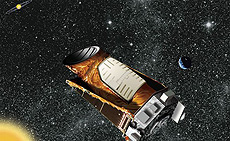Particle physicist lends skills to planet hunt
 |
|
Artist's illustration of Kepler spacecraft. Photo: NASA/ Kepler Mission/ Wendy Stenzel. |
You don’t normally think of high-energy particle physicists working with NASA to find planets that humans could live on. Working on the Large Hadron Collider or dark-energy-seeking telescopes, yeah, but, planet hunting? Not so much.
Yet, Jason Steffen, an astrophysicist at Fermilab, is a long-time member of the Kepler Space Telescope Mission and its only practicing high-energy particle physicist. He has helped make possible the mission’s discoveries announced Wednesday of a six-planet solar system 2,000 light years away, the first Earth-size planet candidate, and the first such candidate that potentially could support human life.
It’s one small step for Steffen and his Kepler collaborators and one giant step for dreamers everywhere.
“In one generation we have gone from extraterrestrial planets being a mainstay of science fiction, to the present, where Kepler has helped turn science fiction into today’s reality,” says NASA administrator Charles Bolden upon announcing the data release.
The Kepler spacecraft-mounted telescope, 11 million miles from Earth, scans the sky to find, for the first time, distant life-sustaining planets the size of Earth. Telescopes can’t directly spot planets smaller than Jupiter, but Kepler uses starlight to indirectly see smaller planets. Planets that could potentially sustain life fall into a Goldilocks-like “habitable zone,” orbiting the perfect distance from a star like our sun so as to not be too hot or too cold. Often these planets’ orbits cross close in front of a star, or “transit,” making them visible through the blinking out of the stars’ light. By measuring the brightness change of a star as a planet passes in front of it, as well as the time between these transits, scientists can tell the planet’s size, orbit, and estimated temperature.
But the closeness to the star that allows Kepler to “see” the planet also often makes it too hot for life. The more distant planets outside Kepler’s view hold a greater chance of being just right to sustain life. Kepler has difficulty spotting these planets because of orbit cycles that are longer than the time frame of the released data or because they do not transit stars.
Read More
|